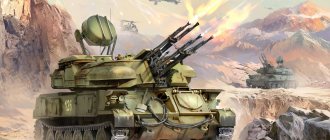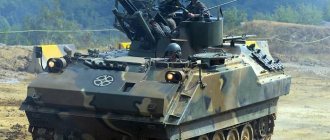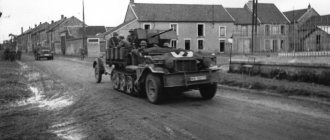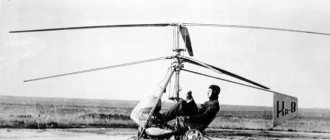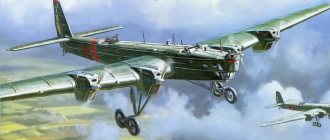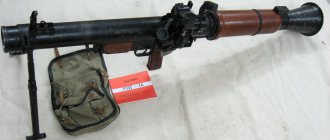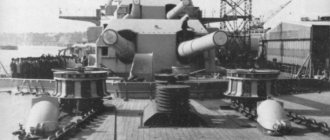ZSU-23-4 “Shilka” is a self-propelled anti-aircraft gun created in the mid-60s of the last century; it is still in service with dozens of armies around the world. Without any exaggeration, the Shilka can be called a unique weapon; of all the anti-aircraft systems built after the Second World War, it has the longest and most impressive track record.
The Middle East became the place of baptism of fire for “Shilka”, then there was the fight against American aviation in Vietnam, numerous conflicts on the African continent and the war in Afghanistan. The Afghan Mujahideen did not have aviation, so the Shilka was used for other purposes: the ZSU-23-4 was used to support ground forces and protect transport convoys. The Dushmans called “Shilka” “shaitan-arba” and were very afraid of her.
ZSU-23-4 is designed to cover ground troops, as well as combat low-flying targets. "Shilka" was part of the air defense of the regimental level. Potential opponents highly appreciated the combat effectiveness of this anti-aircraft system; at one time, the Americans and Israelis spent a lot of effort to obtain it for study.
Currently, the ZSU-23-4 is considered an obsolete anti-aircraft gun; its replacement with the more advanced Tunguska air defense system began back in Soviet times. Despite this, Shilkas are still in service with the armed forces of Russia, Ukraine and several dozen other countries. They are actively used in local conflicts in third world countries.
Since the start of mass production, 6.5 thousand units of these weapons have been manufactured.
History of creation
During the Second World War, air attacks during the march became a big problem for ground forces: attack aircraft, operating at low altitudes, caused enormous damage to manpower and military equipment. The Germans, who at the end of the war suffered severe losses from Western aviation, developed a small-caliber anti-aircraft gun called Kugelblitz (“Ball Lightning”). It had two 30-mm guns and a radar, with the help of which it detected the enemy and aimed at the target. The rate of fire of the Kugelblitz was 850 rounds per minute, and they even tried to install night vision devices on it. This ZSU was far ahead of its time and became the subject of study and copying for many years.
Soviet infantry and tank crews did not have such luxury and suffered greatly from German air raids throughout the war. They began to correct the situation after the victory over the Germans.
In 1947, work began on the creation of a 57-mm self-propelled anti-aircraft gun ZSU-57-2. However, at the time production began, this complex was already outdated. It had a too low rate of fire (220-240 rounds per minute), clip-on loading and an open turret at the top. The ZSU-57-2 did not have a radar, so the target could only be detected visually, and it also did not have a protection system against weapons of mass destruction. Meanwhile, the potential enemy was not asleep: the Americans, having studied captured samples of the German “Ball Lightning”, adopted a 40-mm ZSU with a radar target detection system in 1956.
In 1957, work began in the USSR on the creation of a new self-propelled anti-aircraft gun. Two competing projects were launched at once: the ZSU-37-2 Yenisei, armed with two 37 mm guns, and the ZSU-23-4 Shilka, with four 23 mm guns. Both anti-aircraft installations were equipped with a radar, had a tracked chassis and a system of protection against weapons of mass destruction. Formally, they were intended to solve various tasks: the Yenisei provided protection for armored forces, and the Shilka was supposed to cover motorized rifle units. Both complexes had belt-fed guns and water-cooled barrels.
By 1960, both anti-aircraft systems were ready, and their testing began. The ZSU-23-4 “Shilka” turned out to be 1.5-2 times more effective than its competitor in shooting at low-flying high-speed targets, but the “Yenisei” was superior to it in terms of engagement height. The commission recommended the adoption of both anti-aircraft systems. However, only the Shilka went into production; work on the Yenisei was suspended.
By 1970, "Shilka" became the main mobile anti-aircraft complex of the SA, it completely replaced the ZSU-57-2 and began to be exported. Shilkas were first used during the 1973 Arab-Israeli conflict. Then the Syrian air defense managed to destroy 98 Israeli Air Force aircraft, 10% of which were ZSU-23-4. Heavy anti-aircraft fire at low altitudes had a demoralizing effect on Israeli pilots, forcing them to fly to higher altitudes, where they became easy prey for SAMs.
“Shilkas” were used during the Iran-Iraq War (by both sides), in the final stages of the Vietnam War, and during Operation Desert Storm.
In Afghanistan, Soviet troops used the ZSU-23-4 to destroy ground targets. The unnecessary radar was removed from the Shilka and the ammunition load was increased to 4 thousand shells. After the Shilka appeared on the battlefield, the dushmans usually began to retreat.
The main disadvantage of the Shilka was the insufficient power of the 23-mm projectile; the military was not satisfied with the slanted range of the gun and the insufficient high-explosive effect of the projectiles. When creating a new attack aircraft, the Americans tested on it the effects of a captured Shilka, captured by Jews during the 1973 war. This is how the famous A-10 “Warthog” appeared, which is really well protected from 23 mm anti-aircraft ammunition. The Americans actively advertised this aircraft, calling it invulnerable to Soviet air defense fire.
They tried to convert the ZSU-23-4 to a more powerful 30-mm projectile, but it turned out that it was easier and cheaper to build a new anti-aircraft gun than to modernize an old one. And so it was done: in 1982, the Tunguska ZSU, armed with 30-mm automatic cannons, was put into service.
Over the years of operation of this complex, several modifications have been developed.
Foreigners are not our decree! Self-propelled guns ZSU-45
Home » Alternative tank building » Foreigners are not a decree for us! Self-propelled guns ZSU-45
Editor's Choice Alternative Tank Building
blacktiger63 07/04/2021 3097 133
14
in Favoritesin Favoritesfrom Favorites 8
Having finished with the escort tanks of the MS family , I want to continue with self-propelled guns based on them.
How could this happen? Perhaps like this:
After the sinking of the German captured battleship Ostfriesland in the USA in 1921 with the help of aviation, naval commanders of all countries arose the question of protection from air attack. The solution, as we know, was the development of a diverse MZA zoo. And the first was the English half-pound Pom-Pom, large, complex, heavy, etc., because it was made by an innovative method of scaling the Maxim machine gun. And everyone rushed to develop light and powerful rapid-fire guns. It turned out not very good, too complex and unreliable. And this is in industrialized countries, let alone Soviet Russia. In short, the stone flower never came out of Danila the Master. And protection was needed now, combat aviation was developing like iPhones: every year there was an update. And the Soviet Red Navy soldiers simply had nothing to shoot down enemy planes with. The situation was slightly diluted by 45mm 21-K anti-aircraft guns. But from the very beginning it was clear to everyone that this gun was of little use. The test results of the R-5 torpedo bomber with a victory report, sent to Stalin, added fuel to the fire.
And so, the naval commanders set the naval gunners the task of urgently solving the problem of air defense of ships. The situation was heating up, and there was no way out. During one of the next fruitless brainstorms, someone came across an old photo from the Imperialist era, with the Germans at a 47mm Hotchkiss revolver gun, used as an anti-aircraft gun.
Considering the hopelessness of the situation, we decided to try, especially since old Hotchkiss guns were lying around in the naval warehouses from the Russo-Japanese War. Unexpectedly, it turned out well. The Hotchkiss five-barreled gun, even with its poor ballistics, was better than the Maxim. Of course, turning the handle was unfashionable and inconvenient, so an electric motor was attached to the gun. It turned out great, but there was no ballistics left, and even the shells with black powder... True, the strength of the ancient design was not enough for modern shells. Especially the shutters.
But the path was found. We took 5 barrels from 21-K, an electric motor, and mounted them on a single frame. The increased recoil was compensated for by slotted muzzle brakes.
The re-baked 45mm Hotchkiss had a rate of fire of 500 rounds/min, and the sailors liked everything except the weight. Therefore, on the next gun, five barrels were attached to a faceplate of 5 wedge bolts from 21-K combined into one piece. At the same time, the shutter began to move horizontally and was driven by a copier, from an electric motor. A spring-loaded projectile rammer, also powered by a copier, was added to the design. The anti-aircraft gun perfectly solved air defense problems at low altitudes and became the standard weapon of Soviet battleships and cruisers. But the gun was too heavy for small ships. Therefore, the number of barrels was reduced to three, and the original wedge bolts were left. The result was a completely working design suitable for light ships from destroyers to patrol ships and sea hunters.
The successful naval anti-aircraft gun did not go unnoticed, but its use “on the ground” was limited by the electric drive. An attempt to install an anti-aircraft gun on a car chassis (ZIS-6) gave a negative result - both the gun and the recoil were too heavy for such a chassis. The next iteration was the installation of a cannon on the chassis of the MS-2/3 tank. To do this, the tank body (and it, as we remember, is made of two halves) was lengthened with an insert between the MTO and the BO.
The chassis was made as light as possible by removing everything possible. The weight of the self-propelled guns still increased, but the mobility did not drop much. Weight restrictions did not allow the installation of a protected turret; we had to limit ourselves to small shields at the front. A naval platform for the gun was mounted on the original turret shoulder strap. The ammunition was placed in boxes around the perimeter of the platform and in the BO. A large hatch was made in the VLD for loading ammunition. During testing, the ZSU performed well: the chassis had long been familiar to the troops, the gun was also used in the navy, and the alloy turned out to be reliable and effective. Of course, there were also disadvantages: the lightweight chassis was wobbling with recoil, the ammunition it carried was small, and the armor was clearly not enough. But the ZSU-45 confidently coped with its main task - providing air defense to tank columns on the march. The Luftwaffe immediately felt this in the summer of 1941 and their desire to storm tank columns, as opposed to infantry or artillery, quickly waned. The excellent anti-tank properties of the ZSU also stood out - the fire of automatic cannons from ambushes from a distance of 300-400 meters stopped any German tank. The whirlwind of 45mm armor-piercing shells left neither the Stuga nor the T-4 a chance to survive.
Of course, the ZSU-45 was produced throughout the war; the main chassis for it was the MS-6. A heavier and more stable chassis, increased ammunition - all this made the ZSU-45 at the new base the main anti-aircraft gun of the armored forces of the Red Army. In 1943, the gun received new barrels from the new M-42 anti-tank gun. Shown is a ZSU-45 produced at the end of 1944 on a lightweight chassis
Description of design
ZSU-23-4 "Shilka" has a welded body with bulletproof and anti-fragmentation armor. It is divided into three compartments: control, located in the front of the vehicle, the fighting compartment, located in its center, and the power compartment, in the rear. On the right side of the anti-aircraft gun there are three hatches, through which the equipment of the machine is dismantled and serviced, as well as the ventilation of the units.
The Shilki turret is equipped with a quadruple 23-mm AZP-23 Amur gun, the automation of which operates by removing powder gases from the barrel. Each barrel is equipped with a cooling system casing and a flash suppressor. The cartridge feed is lateral, from a belt link with the cartridge skewed. The tapes are in cartridge boxes. The turret contains two boxes; the system for cocking anti-aircraft guns is pneumatic.
The Shilka ammunition consists of two types of 23-mm shells: armor-piercing BZT and fragmentation OFZT. Armor-piercing BZT ammunition does not have an explosive and contains only an incendiary composition for tracing. OFZT shells have a fuse and a self-destructive device (action time is 5-10 seconds). In a belt for four rounds of OFZT there is one BZT.
Guidance is carried out using hydraulic drives, manual guidance is also possible. The rate of fire is 3400 rounds per minute.
In the instrument compartment of the tower there is a radar-instrument complex, with the help of which the target is searched, tracked, and projectile trajectories and the necessary lead are calculated. The detection range of airborne objects is 18 km.
The Shilka anti-aircraft complex can fire at air targets in several modes:
- in automatic;
- in semi-automatic;
- along foreshortening rings;
- according to remembered coordinates;
- against ground targets.
Automatic firing mode is considered the main one.
The radar-instrument complex consists of the following elements:
- lamp radar 1RL33M2;
- analog counting and solving device;
- sighting device;
- stabilization systems.
The combat vehicle is equipped with an R-123M radio station and a TPU-4 intercom.
ZSU-23-4 "Shilka" is equipped with a V6R diesel engine. It has six cylinders, liquid cooling and a maximum power of 206 kW. The vehicle has two aluminum fuel tanks with a total volume of 515 liters. This was enough for up to 400 km. The additional installation is intended to power the on-board electronics.
The chassis of the machine consists of two drive wheels, two guide wheels and twelve road wheels with rubber-coated rims. Suspension – independent torsion bar.
The crew is protected from weapons of mass destruction by creating excess pressure in the fighting compartment and purifying the air.
The modernization of the Shilka anti-aircraft complex followed the path of improving its ability to detect air targets, as well as increasing the security of the complex. Back in the mid-70s, the Ovod-M-SV complex was created to control the fire of anti-aircraft guns at the regimental level. It included the Luk-23 radar and an automated fire control system.
In the mid-90s, modifications “Shilka-M4” and “Shilka-M5” appeared with more advanced fire control systems. To destroy armored targets, a 23-mm sub-caliber ammunition was created.
In 1999, the Shilka modification was presented to the general public, the turret of which was additionally equipped with Igla MANPADS.
Modifications of ZSU-23-4 Shilka
ZSU-23-4V - modernization in order to increase the operational reliability of the installation, improve the living conditions for the crew, increase the life of the gas turbine unit (GTA) from 300 to 450 hours. To point the tracking radar at a visually detected target, a commander's guidance device (CPN) was introduced into the installation ).
ZSU-23-4V1 - modernization of the counting and solving device in the ZSU-23-4V, which increased the accuracy and efficiency of shooting, the reliability of automatic target tracking when the speed of the installation was increased from 20 to 40 km/h, the service life of the GTA was increased from 450 to 600 hours.
ZSU-23-4M1 - modernization of 2A7 assault rifles and 2A10 guns to 2A7M and 2A10M in order to increase the reliability and stability of the complex. The survivability of barrels has been increased from 3000 to 4500 shots. The reliability of the radar has been improved and the service life of the GTA has been increased from 600 to 900 hours.
ZSU-23-4M2 - modernization of the ZSU-23-4M1 for use in the mountainous conditions of Afghanistan. The RPK was excluded from the installation, due to which the ammunition load of shells was increased from 2000 to 3000, the radar was dismantled, armor protection was strengthened, and night vision equipment was introduced for firing at night targets at ground targets.
ZSU-23-4M3 "Biryuza" - ZSU-23-4M1 with the installation of a ground-based radio interrogator "Luk" of a radar system for identifying air targets on the basis of "friend or foe".
ZSU-23-4M4 Shilka-M4
ZSU-23-4M4 "Shilka-M4" - modernization with the installation of a radar control system and the ability to install the Strelets air defense system. Introducing into the battery the mobile reconnaissance and control point (MRU) “Assembly M1” as a command post (CP) and introducing into the ZSU a telecode communication channel for information exchange between the ZSU and the command post. Replacement of an analog counting and solving device with a modern central digital computer. A digital tracking system is being installed. Modernization of the tracked chassis, aimed at improving the controllability and maneuverability of the self-propelled vehicle and reducing the complexity of its maintenance and operation. The active night vision device is replaced with a passive one. Radio stations are being replaced. An air conditioner and an automated monitoring system for the performance of radio-electronic equipment are installed.
ZSU-23-4M5 "Shilka-M5" - modernization of the ZSU-23-4M4 with the installation of radar and optical-electronic control systems.
ZSU-23-4M-A - Ukrainian modification. The basic radar was replaced with a multifunctional radar with the Rokach-AS CAR, a new optical-location system and missile channel, a digital computer system, and new control algorithms were installed.
Advantages and disadvantages
One of the main disadvantages of the Shilka anti-aircraft gun is its heavy, complex and low-power chassis. Its repair and maintenance is a complex and labor-intensive task. To get to some of its components, it is necessary to dismantle many units, drain the oil and coolant. Power 240 l. s., which the Shilka engine is capable of, is insufficient for its weight, so the car is slow-moving and difficult to maneuver.
In addition, other design errors and shortcomings were made in the power plant and chassis of the vehicle, which resulted in frequent breakdowns of the anti-aircraft gun.
The Shilki radar has a short range and is quite finicky to set up. It should also be added that the car provided a minimum level of comfort for the crew.
However, all of the above disadvantages are offset by the highest level of reliability of the anti-aircraft guns of the complex. If they were correctly assembled and installed, and the cooling system was filled with water according to the standards, then the likelihood of failure or failure during shooting was practically eliminated.
Even today, the Shilka can pose a serious danger to enemy planes and helicopters, unless, of course, they fly too high.
Specifications
Below are the performance characteristics of the ZSU-23-4 “Shilka”.
| Year of adoption | 1962 |
| Dimensions of the affected area, km: | |
| – by range | 0-2,5 |
| – in height | 0-1,5-2 |
| Speed of targets hit, m/s: | |
| - when shooting towards | 450 |
| - when shooting in pursuit | 300 |
| Number and caliber of guns, mm | 4X23 |
| Projectile weight, kg | 0,19 |
| Initial projectile speed, m/s | 1000 |
| Possibility of shooting on the move | Yes |
| All-weather operation | Yes |
| Weight, t | 20,5 |
| Calculation, pers. | 4 |
